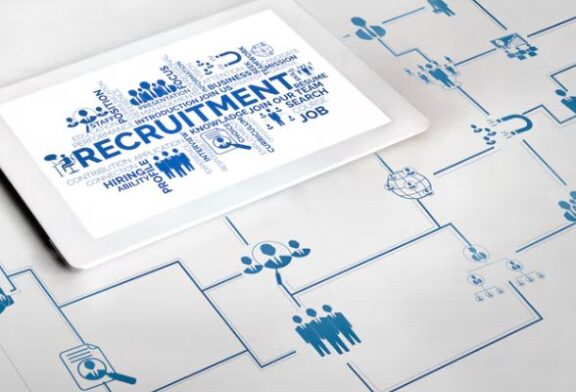Starting a new job can be a stressful experience, and introducing new employees to how things work through a buddy system is an essential part of their onboarding process.
Read on to discover how you can set up a buddy system at work, connecting new starters to an existing employee who can help set them off on the right foot.
What is a buddy system?
A buddy system is the process through which new employees are paired up with an existing employee who can show them the ropes of the organisation. Typically a part of the onboarding process, the buddy system helps a new starter understand their responsibilities as they begin their new role.
A buddy system can last a few weeks or months depending on the complexity of the role and should be focused on knowledge sharing. This means assigning a buddy who can clearly articulate the culture, mindset, and routines of the company, as well as any software and tools used. It also means encouraging the new hire to share tips, knowledge, and any techniques they’ve learned from their prior work experiences.
An effective buddy system is also geared towards socialising the new member of staff. This means introducing them to their colleagues, helping them to make friends, and generally welcoming them onto their new team. The biggest challenge faced by a new employee is answering the question “how are things done around here?” as quickly as possible. The buddy system sets out to do this as efficiently as possible.
In this article, we’ll explore:
- The core benefits of using a buddy system
- When you should introduce the buddy system to the workplace
- How to choose the best employee for the role of buddy
- How to correctly implement a buddy system
- The key responsibilities of a buddy
- How to measure the success of your buddy system
- How to incorporate knowledge sharing as a part of your company’s culture
The benefits of using a buddy system
Using a formal buddy system to help bring new hires up to speed has a range of benefits. New employees who begin their new role in a company with a buddy have a much better impression of the company’s commitment to their success. New hires often begin their role with eagerness and buddy relationships help give an excellent first impression.
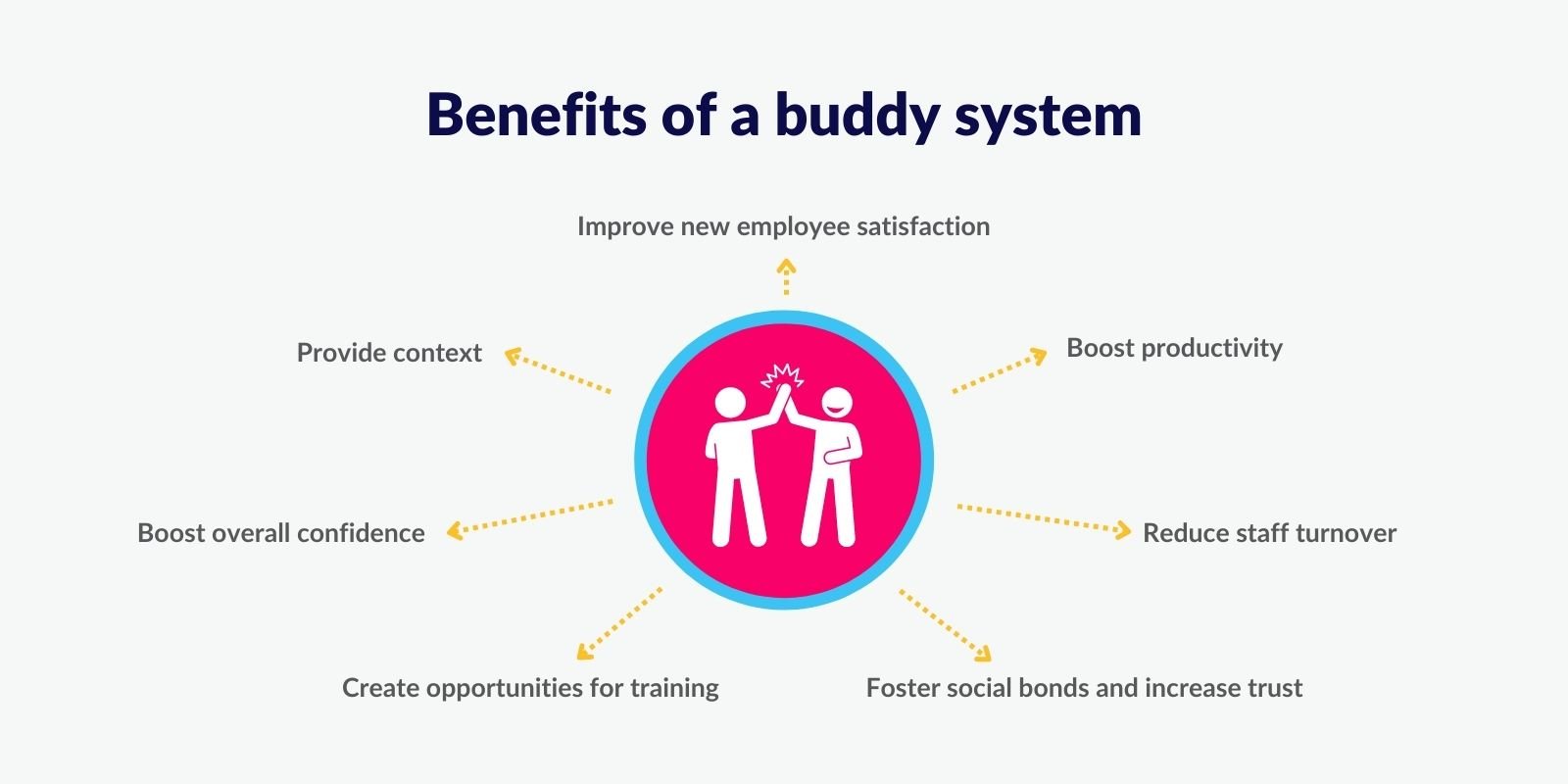
The article from the Harvard Business Review, Every New Employee Needs an Onboarding Buddy, explains how crucial a good buddy is to a successful onboarding process.
“Onboarding buddies play an important role in ensuring a successful onboarding experience. While this may seem obvious, much like our findings on one-on-ones, it’s often missing in a new employee’s introduction to a brand new company. After piloting a buddy program involving 600 employees across the organization, we found that onboarding buddies help our hires in three key ways:”
The three benefits stated by the Harvard Business Review are:
1. Onboarding buddies provide context
New employees require time to understand the context in which their work takes place. This includes understanding who they need to interact with on a day-to-day basis, and what cultural norms and unspoken rules there are to navigate. A buddy will help them negotiate these matters and create a smoother transition into the organisation.
2. Onboarding buddies boost productivity
The longer it takes new employees to get up to speed, the longer it is before they become fully productive members of the workforce. A buddy can help the new hire speed up their productivity by helping them fit into their role and understand the required skills for success.
3. Onboarding buddies improve new employee satisfaction
Assigning a buddy to new employees increases overall employee satisfaction. The Harvard Business Review report explains: “Our research found that after their first week on the job, new hires with buddies were 23% more satisfied with their overall onboarding experience compared to those without buddies. This trend continued at 90 days with a 36% increase in satisfaction.”
Some additional benefits of using a buddy system include:
- Boosting overall confidence. New hires who are introduced to networks of staff members are better able to discuss progress and solicit constructive feedback.
- Creates opportunities for training and development. A buddy system can help highlight areas where formal training may be required to bring them up to speed.
- Fostering social bonds and increasing trust. By helping the new starter to connect with colleagues and form workplace bonds, the buddy helps them integrate into the company and connect with others on a deeper level.
- Reducing staff turnover. New employees who feel they have made new friends early on in their new role are more likely to remain with the company in the long term.
When should a buddy system be introduced?
A buddy system should be introduced at the very beginning of a new employee’s onboarding process. In fact, preparation for a new buddy system begins before they start their first day.
Before the new employee arrives for their first day of work, HR leaders and managers should have already decided who the buddy is going to be. Any preliminary preparations, including setting up their desk and ensuring they have the right tools and software installed, should also be carried out in advance.
The relevant documentation should also be prepared so this is immediately available. This could include the timeline used by the buddy as part of the onboarding process. Additional documentation appropriate for the process such as the company handbook should also be included in this preparation.
Using performance management software’s onboarding and offboarding processes is an effective way to smoothly implement a buddy system. This allows any onboarding documentation to be saved as a template that can be easily modified in accordance with a given role of a new hire.
While a buddy system is most often used for onboarding new hires, it can sometimes be applied to employees who are going through a lateral promotion. If an employee is moving to another team or department where the role is significantly different, a buddy can be assigned to help bring them up to speed on any processes they need to understand.

Who would make a good buddy?
Choosing the right employee for the role of buddy is essential for the process to be implemented effectively. A buddy is essentially an ambassador for the company, and as such, they should embody the values desirable in the new hire.
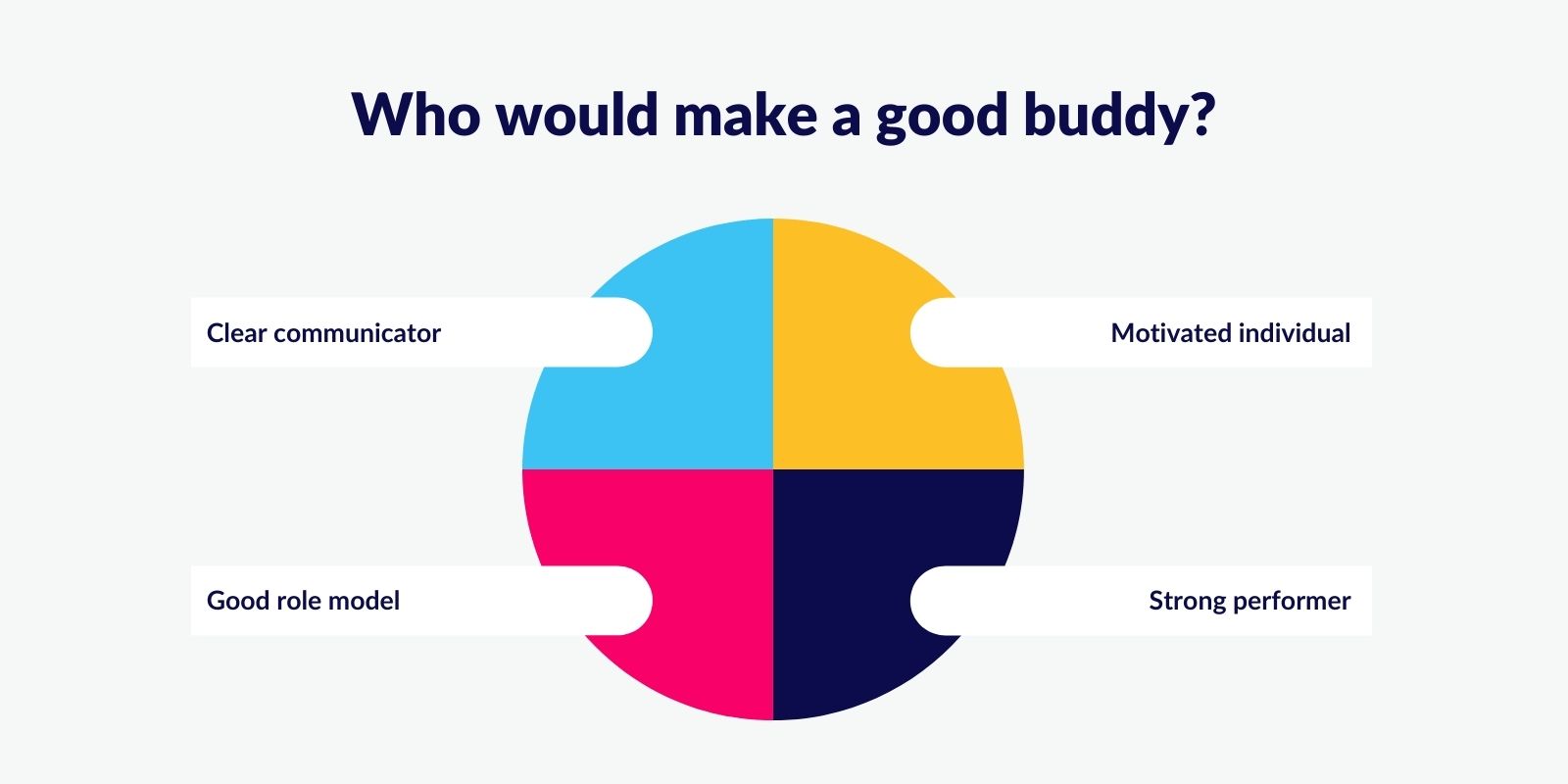
The onboarding guidelines for a new employee’s buddy at New York University outline four key characteristics to look for. These are:
- A clear communicator. A great buddy needs to be able to articulate the relevant information clearly and concisely. They also need to be good conversationalists, capable of engaging in dialogue and maximising the knowledge-sharing aspect of the role.
- A good role model. A buddy should epitomise the values of the organisation, modelling the appropriate behaviours expected of the new employee.
- A motivated individual. A good buddy should exhibit high levels of self-motivation in their role and conduct themselves with a positive outlook.
- A strong performer. An effective buddy is one who excels in their role, and as a result, is in a position to guide the new employee based on their knowledge and experience of the workplace.
Some additional qualities and attributes you should look out for when assigning a buddy include:
- A willingness to take on the role. Don’t assign someone the role of a buddy if they lack the enthusiasm to perform the role to the best of their abilities
- Having the necessary time to buddy up effectively. A buddy who is swamped with their own workload isn’t going to be able to dedicate themselves accordingly to the role
- Possessing the appropriate skills for the new hire’s role. A good buddy should understand the ins and outs of what is expected from the new employee
- Having good relationships with other employees. Since part of the role of the buddy is to help the new hire integrate with their colleagues, they should be well regarded by these employees
5 steps to implementing a buddy system
Implementing a successful buddy system is relatively easy, and can be accomplished by following these 5 main steps.
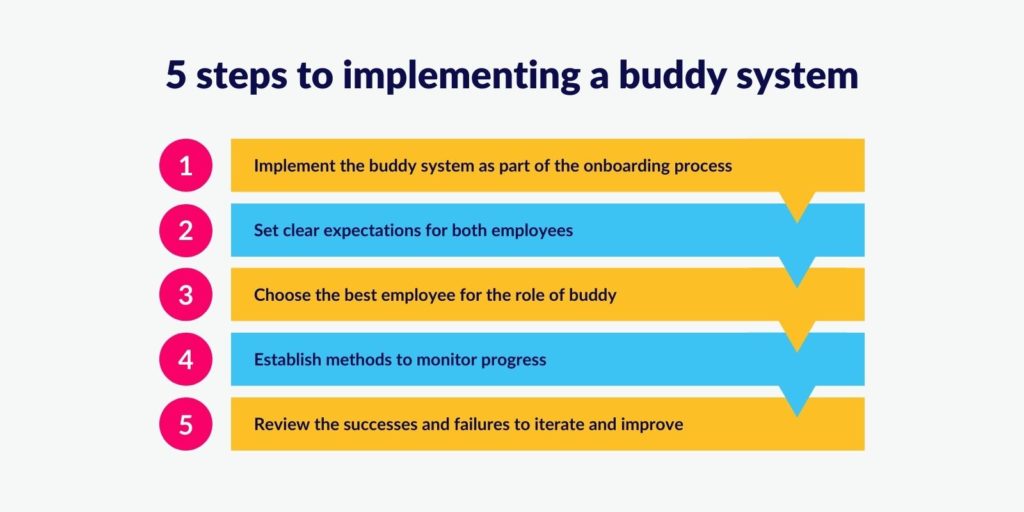
1. Implement the buddy system as part of the onboarding process
A buddy system should be a core aspect of a new hire’s onboarding process. This means assigning a buddy and preparing the groundwork before the new employee arrives at the company. Any documentation should be prepared ahead of time, and the expectations of the assigned buddy laid out in advance.
2. Set clear expectations
Setting clear expectations for both the new hire and the assigned buddy is the next important step to creating a buddy system. This means understanding what the buddy should focus on and in what order, so that progress can be effectively charted as the new employee settles into his or her role.
3. Choose the best employee for the role of buddy
The buddy assigned to a new hire will vary depending on the nature of their role and responsibilities. This means a process of buddy selection needs to be adhered to in order to make sure the best employee for the role is selected. They need to fulfil the requirements outlined above regarding who would make a good buddy, including possessing the relevant experience to offer great guidance.
4. Establish methods to monitor progress
Monitoring the progress of the buddy system allows managers and team leaders to know the program is on the right track. This can be done through a buddy checklist, which outlines each step of the buddy system in detail. This checklist can be processed through performance management software, for instance by entering these phases as objectives and key results (OKRs) with appropriate deadlines.
5. Review the successes and failures to iterate and improve future buddy systems
Once the period of time allocated to the buddy system has concluded, it’s time to review the process to assess its successes and failures. This may require the process to be adjusted for future reference, or emphasise aspects of the program which were particularly successful.
Buddy responsibilities
A buddy’s role entails a number of responsibilities in order to be successful. These responsibilities include:
- Helping the new employee orient themselves around the office, including obtaining office supplies and, if necessary, helping with travel arrangements
- Introducing the new employee to the company’s guidelines and expectations, as well as cultural norms and any unwritten policies
- Giving the new employee an overview of how things are done in the company, including protocols that may not be apparent from other onboarding documentation
- Familiarising the new hire with tools and software relevant to their role, and connecting them with the IT department for ongoing support
- Getting the new employee involved in social activities with colleagues, including informal coffee/lunch activities and any other appropriate social groups
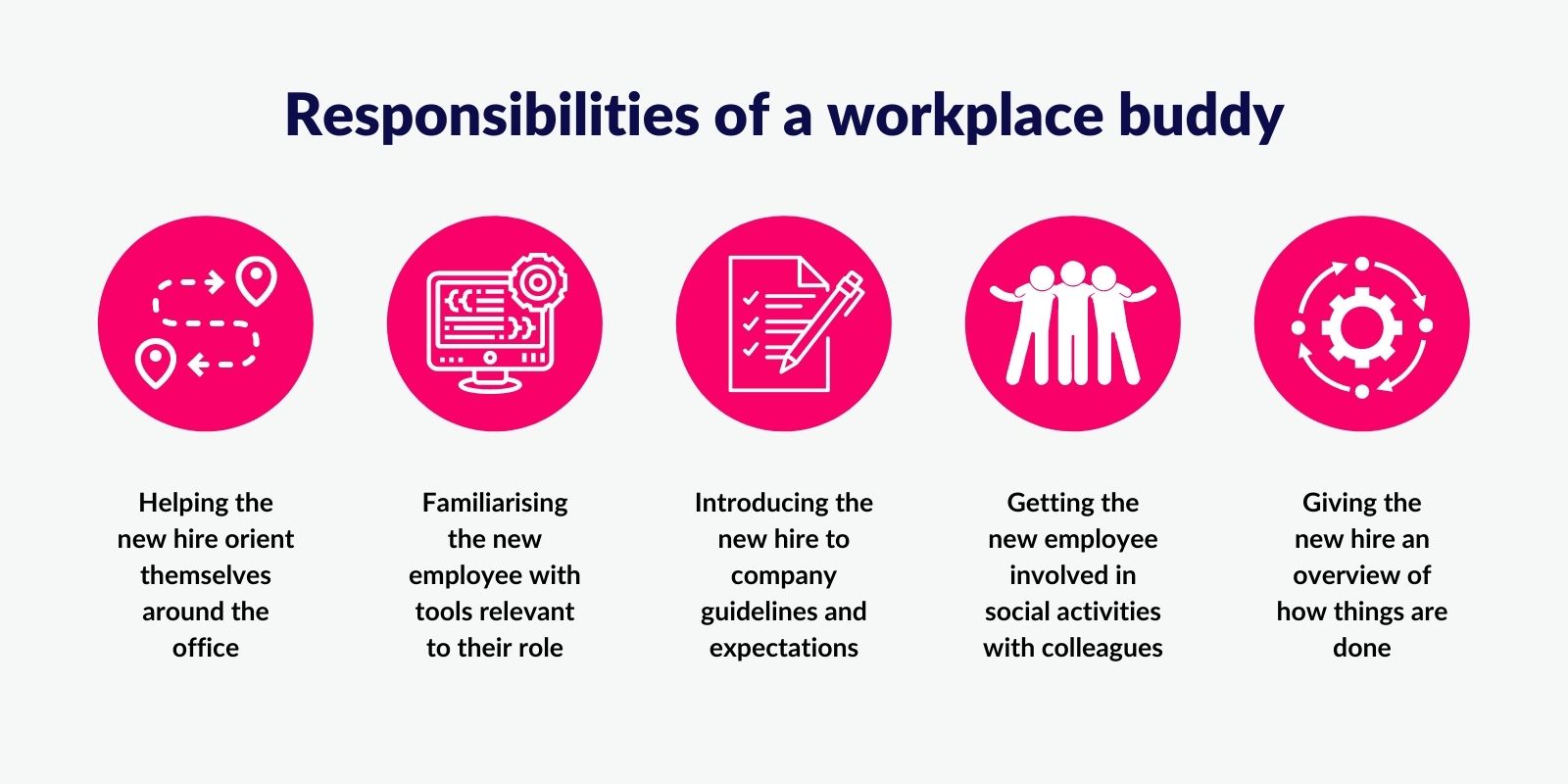
It’s important to make a distinction between a buddy and a coach or mentor. Buddies are not expected to perform the in-depth training duties associated with coaching and mentorship. If the new employee does require coaching in detail, an appropriate employee should be selected to take on this role.
Ways to measure the success of a buddy system
The success of a buddy system can be measured in several ways as the process unfolds once the new hire has started at the company.
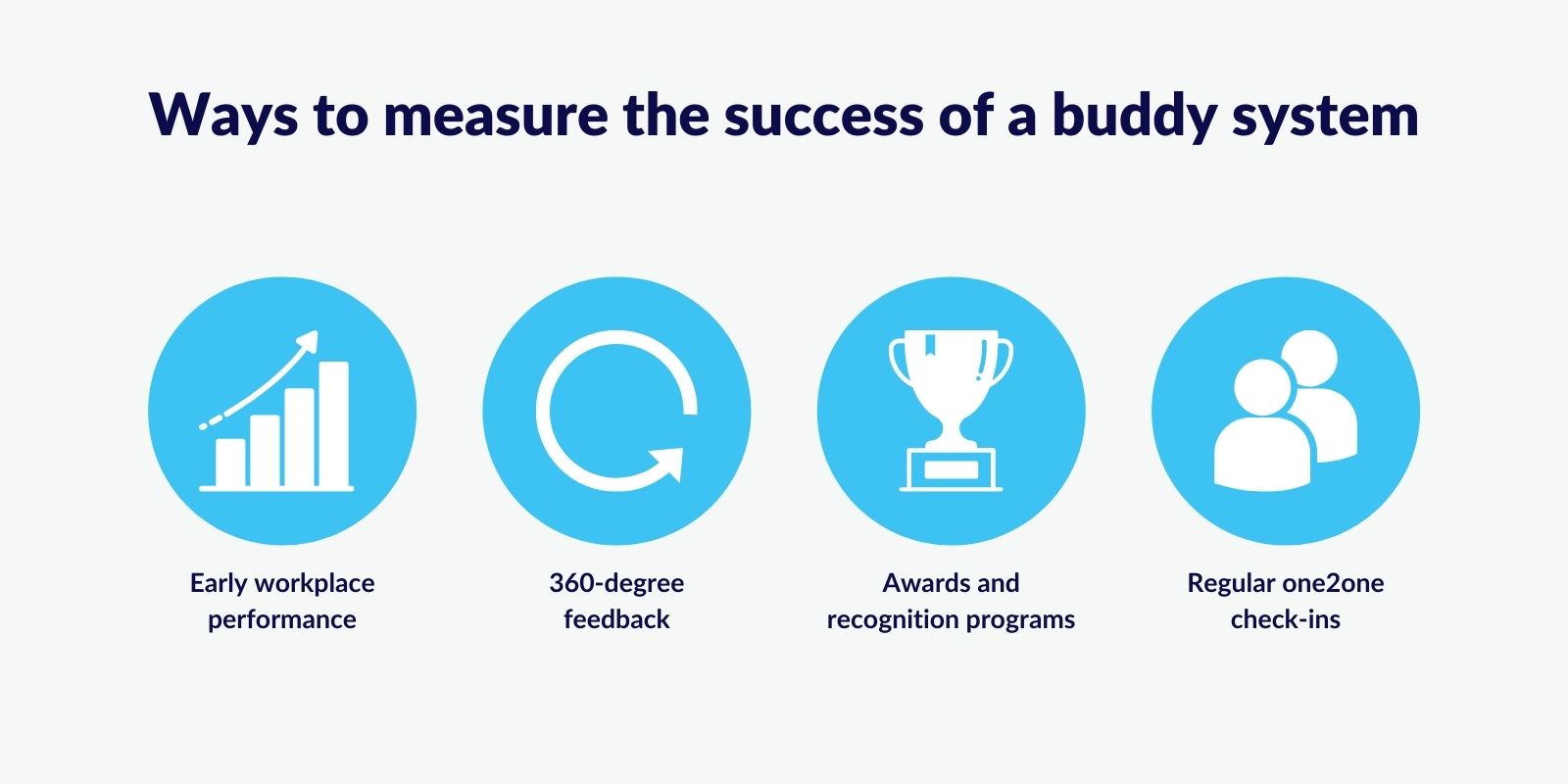
Some of the methods you can use to measure the success of a buddy system include:
- Early workplace performance. When a new hire has been given their first round of performance-related goals, progress towards accomplishing them is a good measure of how well they are integrating.
- 360-degree feedback. 360-degree feedback is an effective tool for gaining a birds’ eye view of employee performance. While it can be time-consuming, if you want to understand a new employee’s performance and integration from a broad perspective, customisable 360-degree appraisals are a powerful way to deliver results.
- Awards and recognition programs. By using performance management software that includes integrated awards and recognition tools, managers can track the development of a new hire in real-time. Since these tools allow for peer-to-peer recognition, they help reflect how well the new employee is fitting in with their teammates.
- Regular one2one check-ins. The simplest way to find out how well a new hire is adapting to their role is to conduct regular one2one check-ins. Schedule these for once a week when they first join the organisation to help keep them on the right track and address any issues as and when they arise.
Have knowledge sharing as part of the company culture
While knowledge sharing is a fundamental aspect of a great buddy system, it can be extended into the wider workforce. Indeed, knowledge sharing should be a core component of a company’s culture, and the correct resources should be put in place to help facilitate this.
Keep track of workforce skills with departmental and organisational charts
An efficient HR department should keep a clear record of the workforce through departmental and organisational charts. These charts will include information on the roles of its employees, and also the qualifications and skills they possess. Such charts are an invaluable resource for identifying potential buddies, as well as employees with the skills and experience to act as coaches or mentors.
Provide access to resources through social intranets and forums
Company intranets and forums are ideal locations to store a wide range of training resources and other material to help share knowledge. These can be curated by members of staff over time to help ensure the range of resources is as comprehensive as possible.
Keep employees in the loop through a company newsfeed
Newsfeeds can be used to promote new training material and other knowledge-based resources throughout the company as and when they arise. If these resources are time-bound, critical alerts can be sent to make sure the relevant employees have read and understood the material.



